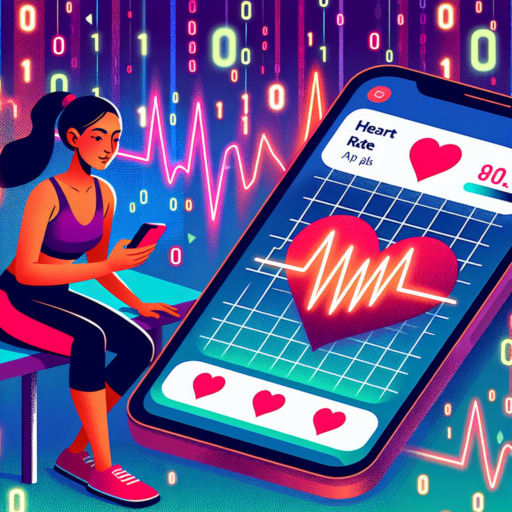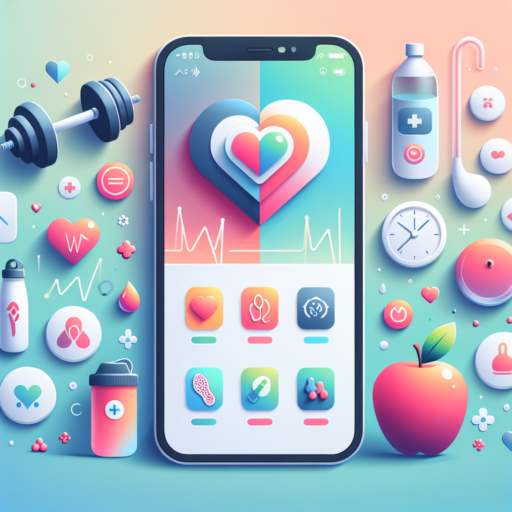What Are Heart Rate Apps and How Do They Work?
Heart rate apps are innovative tools designed to monitor and track your heart rate using your smartphone or smartwatch. These apps rely on advanced technology to provide insights into your cardiovascular performance, offering a convenient way to keep an eye on your heart health. The core functionality of heart rate apps revolves around using the device’s built-in sensors or external hardware to measure the heart’s beats per minute (BPM), a critical indicator of your heart’s health and fitness levels.
At the heart of these apps’ operation is either photoplethysmography (PPG) technology for smartphones or electrocardiogram (ECG) readings for more advanced devices. PPG technology works by using the phone’s camera and flashlight to illuminate the skin and measure changes in blood volume, while ECG-equipped devices provide more accurate readings by measuring the electrical activity generated by the heart. This sophisticated approach allows heart rate apps to deliver real-time data and long-term tracking of heart rate variability, enabling users to monitor their health trends over time.
Furthermore, these apps often come with additional features that enhance their functionality. For instance, they might include workout analysis, offer breathing exercises for stress management, and provide recommendations for improving cardiovascular health. By integrating seamlessly with other health apps and wearables, heart rate apps create a comprehensive ecosystem for health and fitness monitoring, making it easier than ever to maintain a healthy lifestyle.
The Best Heart Rate Apps of 2023: Top Picks for Fitness Enthusiasts
In 2023, the landscape of heart rate monitoring apps has seen significant advancements, making it easier than ever for fitness enthusiasts to track their heartbeats accurately and efficiently. Among the plethora of options available, certain apps have distinguished themselves by offering unparalleled precision, user-friendly interfaces, and holistic health tracking features. These apps not only help in monitoring heart rate during various physical activities but also assist users in understanding their heart health better, optimizing workouts, and achieving fitness goals effectively.
One of the standout features of the best heart rate apps this year is their compatibility with multiple wearables and devices. Users can now seamlessly sync their preferred app with smartwatches, fitness bands, and even smartphones, ensuring constant monitoring without the need for additional gadgets. This integration with everyday devices means that checking your heart rate, whether you’re in the midst of a high-intensity workout or going about your day, is more accessible than ever.
Moreover, these top-rated apps go beyond mere heart rate monitoring. They incorporate comprehensive health metrics, including stress levels, sleep quality, and recovery status, to provide a holistic overview of users’ wellbeing. With real-time feedback and personalized insights based on heart rate data, fitness enthusiasts can fine-tune their routines, set realistic health goals, and monitor progress over time. This high level of personalization and detailed health tracking make these apps invaluable tools for anyone looking to enhance their fitness journey.
How Accurate Are Heart Rate Apps? A Look at the Technology Behind Them
Heart rate apps have become a popular tool for monitoring heart health and fitness levels, sparking curiosity about the accuracy of these digital companions. Leveraging advanced technology, these apps aim to deliver real-time heart rate information, but how reliable are the results they provide? This scrutiny is essential, given the health implications of heart rate data.
Photoplethysmography (PPG) technology is the cornerstone upon which many heart rate apps are built. This method utilizes your phone’s camera and flashlight to measure heart rate by detecting changes in blood volume during heartbeats. Light emitted from the smartphone’s flashlight penetrates the skin, and the camera tracks the amount of light that gets reflected back. Although innovative, the accuracy of PPG can be influenced by several factors, such as movement, lighting conditions, and the quality of the smartphone’s camera and flashlight.
Algorithm enhancements have been a significant leap forward in improving the precision of heart rate apps. Developers continually refine algorithms to better interpret the data captured by PPG technology, aiming to filter out noise caused by movement or poor lighting. However, these improvements, while valuable, do not guarantee the results are on par with medical-grade devices. Moreover, the way an individual uses the app—holding the phone too tightly or too loosely, for example—can further affect accuracy.
In summary, while heart rate apps provide a convenient and accessible way to monitor heart rate, their accuracy is influenced by the technology used, as well as how they are used. Understanding these limitations is crucial for anyone relying on these apps for heart health management.
Comparing Heart Rate Apps: Features You Should Look Out For
When it comes to choosing a heart rate app, identifying the right features can significantly enhance your experience and results. These apps come packed with various functionalities, but knowing which ones stand out can make all the difference in your health and fitness journey. From real-time monitoring to insightful analytics, the key features of heart rate apps pave the way for a more informed and engaging approach to heart health.
Real-Time Heart Rate Monitoring
One of the most critical features to consider is real-time heart rate monitoring. This feature allows for immediate feedback on your heart rate, whether you’re at rest, engaging in daily activities, or pushing your limits during a workout. Apps that offer this can help you adjust your effort on the fly, ensuring you stay within safe heart rate zones tailored to your fitness goals and health needs. Real-time data is invaluable for maximizing the benefits of your exercise regimen without overexerting yourself.
Detailed Analytics and Reports
Beyond just tracking your heart rate, the best apps provide detailed analytics and reports. These insights can uncover patterns in your heart rate over time, correlating them with activities, stress levels, and even the quality of your sleep. By understanding these trends, you can make informed decisions about your lifestyle and exercise routines, potentially leading to better heart health and overall well-being. Look for apps that offer customizable reports that cater to your specific health metrics and goals.
Integration with Other Health Apps and Devices
Finally, the ability to integrate with other health apps and devices significantly enhances the utility of a heart rate app. This feature enables a cohesive health management ecosystem, allowing your heart rate data to work in harmony with other health metrics collected by different apps and devices. Integration can provide a comprehensive overview of your health, offering insights that might not be apparent when viewing data from a single source. Compatibility with a broad range of devices ensures that you can maintain a seamless health tracking experience, regardless of the gadgets you use.
No se han encontrado productos.
Using Heart Rate Apps for Effective Workout Tracking
In the realm of fitness technology, heart rate apps have emerged as indispensable tools for those looking to optimize their workouts effectively. These apps leverage the power of smart devices to offer real-time feedback on one’s heart rate, making it easier to gauge the intensity of a workout session. Whether you’re a seasoned athlete or just starting your fitness journey, understanding how to use these apps can significantly enhance your training efficiency.
Key Features to Look For
When choosing a heart rate tracking app, several key features stand out. Firstly, accuracy is paramount; the app should provide reliable data that you can trust. Another essential feature is usability; the app should be user-friendly, with an intuitive interface that makes tracking your heart rate straightforward. Additionally, look for apps that offer real-time analysis, allowing you to adjust your workout intensity on the fly to stay within your target heart rate zones.
Integrating heart rate apps into your workout regimen can unlock new insights into your fitness levels and progression. For example, tracking the variability of your heart rate over time can indicate improvements in your cardiovascular health. Furthermore, by identifying your peak heart rate zones, you can tailor your workouts to maximize fat burn or enhance cardiovascular endurance. This precise approach to training can lead to more efficient workouts and better overall fitness outcomes.
Integrating Heart Rate Apps with Other Health and Fitness Tools
Integrating heart rate apps with other health and fitness tools has become an essential approach to achieving a comprehensive understanding of one’s fitness and health metrics. When heart rate data is combined with other health monitoring tools, individuals can gain a more detailed picture of their workout intensity, recovery needs, and overall cardiovascular health. This integration helps in creating a personalized fitness plan that catizes to an individual’s specific health goals and requirements.
One of the primary benefits of integrating heart rate apps with other fitness tools is the ability to track progress over time. By monitoring heart rate in conjunction with metrics like steps taken, calories burned, and sleep quality, users can identify patterns and make informed decisions about their health and fitness routine. This holistic approach to health tracking encourages individuals to consider all aspects of their well-being, rather than focusing solely on one metric.
Key Tools for Integration
- Fitness Trackers: These devices are known for their versatility in tracking various health metrics, including heart rate. Connecting a heart rate app to a fitness tracker can enhance the accuracy of workout logs and recovery recommendations.
- Nutrition Apps: Understanding the relationship between diet, exercise, and heart rate is crucial for achieving fitness goals. Integrating heart rate data with nutrition apps can help users tailor their diet plans based on their energy expenditure and recovery needs.
- Sleep Monitors: Sleep quality significantly affects heart health and exercise recovery. By integrating heart rate apps with sleep monitors, individuals can assess how well their body recovers during sleep and adjust their fitness routines accordingly.
The effectiveness of integrating heart rate apps with other health and fitness tools lies in the personalized insights gained from combined data analysis. This holistic view enables more precise adjustments to exercise routines, dietary habits, and lifestyle choices, driving towards optimal health and fitness levels.
Tips for Getting the Most Out of Your Heart Rate App
Utilizing a heart rate app effectively can transform your health and fitness journey, offering insights into your physical condition, workout intensity, and overall well-being. To maximize the benefits of your heart rate app, consider incorporating these practical tips into your routine.
Set Personal Goals
First and foremost, establish clear, attainable goals for what you hope to achieve with the help of your heart rate app. Whether it’s improving cardiovascular health, enhancing endurance, or tracking stress levels, having specific objectives can guide how you use the app and interpret its data.
Understand Your Heart Rate Zones
Knowledge of your heart rate zones is crucial for effective training. Different zones correspond to varying levels of exercise intensity, from light activity to maximum effort. By understanding and applying these zones to your workouts, you can tailor your exercise regimen to match your fitness goals accurately, whether that’s fat burning, improving aerobic capacity, or enhancing athletic performance.
Integrate with Other Health Data
To get a holistic view of your health, sync your heart rate app with other health monitoring tools and apps you use. This integration can provide comprehensive insights, such as how your sleep quality or daily steps correlate with your heart rate trends, offering a more in-depth understanding of your overall health and fitness levels.
Heart Rate Apps vs. Wearable Devices: Which Is Better for Monitoring Your Heart Rate?
In the digital era, monitoring your heart rate has become more accessible than ever. With the advent of heart rate apps and wearable devices, individuals now have the privilege to track their heart health seamlessly. Each method offers unique advantages, raising the question: which is better for monitoring your heart rate?
Understanding Heart Rate Apps
Heart rate apps have revolutionized the way we monitor our heart health. They are not only accessible but also user-friendly, allowing users to check their heart rate using just their smartphones. These apps often use the phone’s camera and flashlight to measure your pulse by detecting changes in your fingertop’s color as your heart beats. This convenience, however, comes with a caveat. The accuracy of heart rate apps can sometimes be affected by external factors such as lighting conditions and camera quality. Additionally, while they provide instant readings, heart rate apps lack the capability to track heart rate continuously or provide detailed historical data analysis.
Advantages of Wearable Devices
On the other hand, wearable devices like fitness trackers and smartwatches have become the gold standard for continuous heart rate monitoring. These devices use sensors to track your heart rate 24/7, offering insights into your heart health over time. **Wearable devices** not only monitor your heart rate but also analyze patterns, detect irregularities, and even provide notifications for abnormally high or low heart rates. Such comprehensive monitoring is invaluable for individuals looking to keep a close eye on their cardiovascular health. Additionally, the ability to store and review historical heart rate data helps in identifying trends and making informed decisions about one’s health and fitness regimen.
Choosing between a heart rate app and a wearable device ultimately depends on your specific needs and preferences. If you seek convenience and sporadic monitoring, heart rate apps might suffice. However, for those vested in detailed analysis and continuous tracking, **wearable devices** offer a more robust solution. Understanding the strengths and limitations of each can guide you in selecting the method that aligns best with your heart health goals.
Understanding Your Heart Rate Data: A Guide for Beginners
Grasping the nuances of your heart rate data can initially seem daunting. However, breaking down the essentials makes it much more approachable. Heart rate data, reflecting the number of times your heart beats per minute, serves as a window into your physical health and fitness level. It aids in identifying how efficiently your heart is working and how you can adjust your fitness regime for optimal health benefits.
At the core of understanding your heart rate lies the concept of heart rate zones. These zones divide your heart rate into different levels, each indicating a specific intensity of exercise. For instance, exercising in a certain heart rate zone can tell you if you’re pushing your limits or just lightly tapping into your cardio capacity. Recognizing the significance of resting heart rate (RHR) versus maximum heart rate (MHR) is fundamental. Your RHR provides insight into your general fitness level and heart health, while your MHR establishes the upper threshold of what your cardiovascular system can handle during physical activity.
Analyzing heart rate variability (HRV) is another crucial aspect when dissecting heart rate data. HRV refers to the time variation between each heartbeat, which can indicate your body’s stress levels and resilience. A higher HRV suggests a healthier, more resilient heart that can efficiently manage stress, whereas lower HRV can indicate stress, fatigue or potentially underlying health conditions. Tracking your HRV, alongside your heart rate, offers a comprehensive view of not just your fitness, but also your wellbeing.
With wearable technology becoming increasingly accessible, monitoring your heart rate data has never been easier. These devices provide real-time insights, allowing for on-the-spot adjustments to your workout intensity, based on your heart rate zones. However, understanding the basics of what this data represents and how to utilize it effectively remains crucial for anyone looking to enhance their fitness journey consciously.
Improving Your Cardiovascular Health with Heart Rate Apps
En la era digital, mejorar la salud cardiovascular se ha vuelto accesible gracias a la innovación de las aplicaciones de frecuencia cardíaca. Estas herramientas modernas no solo monitorean tu ritmo cardíaco en tiempo real, sino que también ofrecen análisis detallados para optimizar tu entrenamiento y fortalecer tu corazón. Al comprender cómo las variaciones en tu frecuencia cardíaca pueden indicar diferentes niveles de salud cardiovascular, puedes ajustar tu rutina de ejercicios para obtener el máximo beneficio.
Los expertos sugieren que el uso regular de apps de frecuencia cardíaca puede contribuir significativamente a prevenir enfermedades del corazón, alentando a los usuarios a mantenerse dentro de zonas de frecuencia cardíaca objetivo durante el ejercicio. Estas zonas, determinadas por la edad, el peso y la condición física general, aseguran que cada sesión de entrenamiento sea eficaz sin sobrecargar el corazón. Al adherir a estas recomendaciones, las apps de ritmo cardíaco sirven como un puente hacia una mejor salud cardiovascular.
La tecnología detrás de estas apps varía, desde el uso de sensores ópticos que detectan el flujo sanguíneo a través de la piel hasta el empleo de algoritmos sofisticados que analizan los cambios en tus datos de frecuencia cardíaca a lo largo del tiempo. Estas tecnologías no solo hacen que el monitoreo de la salud cardíaca sea más accesible sino que también personalizan la experiencia de cada usuario. Al adaptarse a tus necesidades y progreso único, las aplicaciones de ritmo cardíaco pueden jugar un papel crucial en la prevención de enfermedades cardiovasculares y en la promoción de un estilo de vida más saludable y activo.




